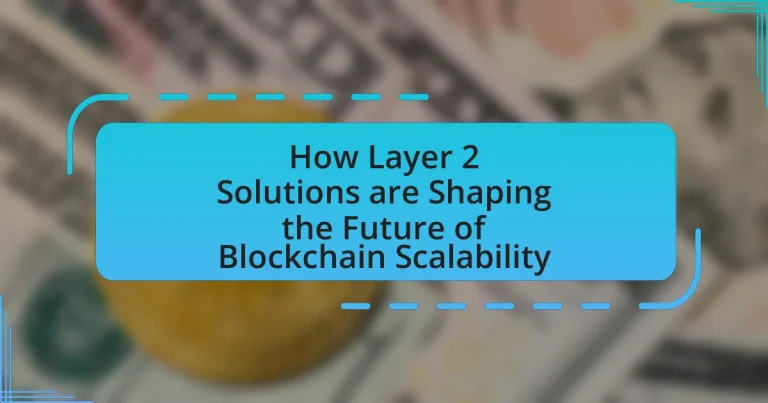Layer 2 solutions are advanced protocols designed to enhance the scalability and transaction speed of existing blockchain networks. This article explores how these solutions, including state channels, sidechains, and rollups, facilitate off-chain transactions to alleviate congestion on the main blockchain, resulting in faster processing times and reduced fees. It also examines the differences between Layer 1 and Layer 2 solutions, the necessity of Layer 2 for addressing scalability challenges, and the impact of these technologies on user experience and various industries. Additionally, the article discusses future trends, potential challenges, and best practices for implementing Layer 2 solutions in blockchain ecosystems.
What are Layer 2 Solutions in Blockchain?
Layer 2 solutions in blockchain are protocols built on top of existing blockchain networks to enhance scalability and transaction speed. These solutions, such as the Lightning Network for Bitcoin and Optimistic Rollups for Ethereum, enable off-chain transactions that reduce the load on the main blockchain, allowing for faster processing and lower fees. By facilitating a higher volume of transactions without congesting the base layer, Layer 2 solutions significantly improve the overall efficiency of blockchain systems, addressing the scalability challenges faced by many networks.
How do Layer 2 Solutions enhance blockchain scalability?
Layer 2 solutions enhance blockchain scalability by enabling off-chain transactions that reduce the load on the main blockchain network. These solutions, such as state channels and rollups, allow multiple transactions to be processed outside the main chain, which significantly increases transaction throughput and decreases latency. For instance, the Lightning Network for Bitcoin can handle millions of transactions per second by settling most transactions off-chain, only recording final states on the blockchain. This approach not only alleviates congestion but also lowers transaction fees, making blockchain networks more efficient and accessible for users.
What are the key features of Layer 2 Solutions?
Layer 2 Solutions primarily enhance blockchain scalability by enabling faster transactions and reducing congestion on the main blockchain. These solutions achieve this through features such as off-chain processing, which allows transactions to be executed outside the main chain, thereby alleviating the load on the primary network. Additionally, Layer 2 Solutions often utilize state channels, enabling participants to conduct multiple transactions without needing to record each one on the blockchain immediately, which significantly decreases transaction fees and increases speed. Furthermore, they can implement rollups, which bundle multiple transactions into a single one, optimizing data storage and improving throughput. These features collectively contribute to a more efficient and scalable blockchain ecosystem.
How do Layer 2 Solutions differ from Layer 1 solutions?
Layer 2 solutions differ from Layer 1 solutions primarily in their operational layer and scalability approach. Layer 1 solutions, such as Bitcoin and Ethereum, operate on the base blockchain layer, handling all transactions and smart contracts directly on-chain, which can lead to congestion and slower transaction speeds. In contrast, Layer 2 solutions, like the Lightning Network for Bitcoin or Optimistic Rollups for Ethereum, operate on top of the Layer 1 blockchain, enabling faster transactions and reduced fees by processing transactions off-chain and then settling them back to the main chain. This distinction allows Layer 2 solutions to significantly enhance scalability and efficiency while maintaining the security of the underlying Layer 1 blockchain.
Why are Layer 2 Solutions necessary for blockchain networks?
Layer 2 solutions are necessary for blockchain networks to enhance scalability and transaction throughput. Traditional blockchain networks, like Bitcoin and Ethereum, face limitations in processing speed and transaction costs due to their consensus mechanisms and network congestion. For instance, Ethereum can handle approximately 30 transactions per second, which is insufficient for widespread adoption. Layer 2 solutions, such as the Lightning Network for Bitcoin and Optimistic Rollups for Ethereum, enable off-chain transactions that reduce the load on the main blockchain, allowing for faster and cheaper transactions. This approach not only alleviates congestion but also improves user experience, making blockchain technology more viable for everyday applications.
What scalability challenges do current blockchain systems face?
Current blockchain systems face significant scalability challenges, primarily due to limitations in transaction throughput and speed. For instance, Bitcoin processes approximately 7 transactions per second, while Ethereum handles around 30 transactions per second, which is insufficient for mass adoption and high-demand applications. These limitations arise from the consensus mechanisms used, such as Proof of Work, which require extensive computational resources and time to validate transactions. Additionally, network congestion can lead to increased transaction fees and slower confirmation times, further hindering scalability.
How do Layer 2 Solutions address these challenges?
Layer 2 solutions address scalability challenges by enabling faster and cheaper transactions while reducing the load on the main blockchain. These solutions, such as state channels, sidechains, and rollups, process transactions off the main chain and only settle final states on the blockchain, significantly increasing throughput. For instance, Ethereum’s rollups can achieve thousands of transactions per second compared to the main chain’s limitations, demonstrating their effectiveness in enhancing scalability.
What types of Layer 2 Solutions exist?
There are several types of Layer 2 solutions that exist, primarily including state channels, sidechains, and rollups. State channels allow participants to conduct transactions off-chain while only settling the final state on-chain, significantly reducing congestion and fees. Sidechains operate independently of the main blockchain, enabling assets to be transferred between chains, which enhances scalability and flexibility. Rollups, which can be further categorized into optimistic and zk-rollups, bundle multiple transactions into a single one, minimizing on-chain data and improving throughput. These solutions collectively address the scalability challenges faced by blockchain networks, as evidenced by their increasing adoption in various projects to enhance transaction speed and reduce costs.
How do state channels work in Layer 2 Solutions?
State channels in Layer 2 solutions enable off-chain transactions between participants, allowing them to interact without congesting the main blockchain. This mechanism works by creating a private channel where participants can conduct multiple transactions, which are only recorded on the blockchain when the channel is closed. This significantly reduces the number of on-chain transactions, enhancing scalability and lowering fees. For instance, the Lightning Network for Bitcoin utilizes state channels to facilitate instant payments, demonstrating how this approach can effectively scale blockchain networks while maintaining security and decentralization.
What are the advantages of using state channels?
State channels offer significant advantages for blockchain scalability by enabling off-chain transactions that reduce congestion on the main blockchain. This mechanism allows participants to conduct multiple transactions without needing to record each one on the blockchain, which minimizes transaction fees and speeds up processing times. Additionally, state channels enhance privacy since transaction details are not publicly visible until the final state is settled on-chain. This approach also allows for instant finality, as participants can resolve disputes off-chain, leading to a more efficient and user-friendly experience.
What limitations do state channels have?
State channels have several limitations, including the requirement for participants to be online and the inability to handle disputes without reverting to the main blockchain. These channels necessitate that both parties are actively engaged to initiate and finalize transactions, which can hinder usability in scenarios where one party is unavailable. Additionally, if a disagreement arises, the resolution process must occur on the main blockchain, which can negate the speed and efficiency benefits that state channels aim to provide.
What role do sidechains play in Layer 2 Solutions?
Sidechains serve as a crucial component of Layer 2 solutions by enabling the transfer of assets and data between different blockchains while alleviating congestion on the main chain. They operate independently from the primary blockchain, allowing for faster transactions and lower fees, which enhances scalability. For instance, the Liquid Network, a sidechain for Bitcoin, facilitates quicker transactions and confidential transfers, demonstrating how sidechains can improve overall network efficiency. This functionality allows Layer 2 solutions to effectively manage increased transaction volumes without compromising the security and integrity of the main blockchain.
How do sidechains improve transaction throughput?
Sidechains improve transaction throughput by allowing transactions to occur on separate chains that are interoperable with the main blockchain. This separation reduces congestion on the primary chain, enabling faster processing times and increased transaction capacity. For instance, Bitcoin’s Liquid Network is a sidechain that facilitates quicker transactions by offloading them from the Bitcoin main chain, thus enhancing overall scalability. By utilizing sidechains, blockchains can handle a higher volume of transactions simultaneously, which is essential for meeting the demands of growing user bases and applications.
What are the security implications of using sidechains?
Using sidechains introduces several security implications, primarily related to the potential for reduced security compared to the main blockchain. Sidechains operate independently, which means they may not benefit from the same level of decentralization and consensus mechanisms as the primary chain, making them more susceptible to attacks such as double-spending or 51% attacks. For instance, if a sidechain has a lower hash rate or fewer validators, it becomes easier for malicious actors to compromise its integrity. Additionally, the transfer of assets between the main chain and sidechain can create vulnerabilities, as the locking and unlocking mechanisms may be exploited if not properly secured. This was highlighted in the case of the RSK sidechain, where vulnerabilities in the bridge mechanism led to concerns about asset security.
What are rollups and how do they function?
Rollups are Layer 2 scaling solutions that aggregate multiple transactions into a single batch, which is then processed on the main blockchain. They function by executing transactions off-chain while maintaining the security of the main chain, allowing for increased throughput and reduced fees. Rollups can be categorized into two types: optimistic rollups, which assume transactions are valid and only check for fraud when challenged, and zk-rollups, which use zero-knowledge proofs to validate transactions without revealing the underlying data. This mechanism significantly enhances scalability, as evidenced by Ethereum’s implementation of rollups, which has led to a substantial increase in transaction capacity while lowering costs for users.
What are the differences between optimistic and zk-rollups?
Optimistic rollups and zk-rollups differ primarily in their approach to transaction validation. Optimistic rollups assume transactions are valid by default and only challenge them when fraud is suspected, requiring a dispute resolution period. In contrast, zk-rollups utilize zero-knowledge proofs to validate transactions off-chain, ensuring correctness before they are submitted to the main chain. This fundamental difference leads to varying security models and performance characteristics; optimistic rollups can have longer finality times due to the challenge period, while zk-rollups provide immediate finality and enhanced privacy through cryptographic proofs.
How do rollups impact transaction costs and speed?
Rollups significantly reduce transaction costs and increase speed by aggregating multiple transactions into a single batch before submitting them to the main blockchain. This aggregation minimizes the amount of data that needs to be processed on-chain, which lowers fees associated with each individual transaction. For example, Ethereum’s Optimistic Rollups can achieve transaction speeds of up to 2,000 transactions per second, compared to the Ethereum mainnet’s typical capacity of around 30 transactions per second. Additionally, rollups can lower gas fees by distributing the costs across many transactions, making it more economical for users.
How are Layer 2 Solutions shaping the future of blockchain scalability?
Layer 2 solutions are significantly enhancing blockchain scalability by enabling faster transaction processing and reducing congestion on the main blockchain network. These solutions, such as state channels and rollups, allow transactions to occur off-chain while still leveraging the security of the underlying blockchain. For instance, Ethereum’s rollups can increase throughput to thousands of transactions per second, compared to the main chain’s limitations of around 30 transactions per second. This scalability improvement is crucial for supporting a growing number of decentralized applications and user demand, as evidenced by the increasing adoption of Layer 2 solutions in various sectors, including finance and gaming.
What impact do Layer 2 Solutions have on user experience?
Layer 2 solutions significantly enhance user experience by improving transaction speed and reducing costs. These solutions, such as state channels and rollups, allow for off-chain processing, which alleviates congestion on the main blockchain. For instance, Ethereum’s Layer 2 solutions can process thousands of transactions per second compared to the main chain’s limitations, resulting in faster confirmations and lower fees. This improvement leads to a more seamless and efficient interaction for users, making blockchain technology more accessible and practical for everyday applications.
How do Layer 2 Solutions reduce transaction fees for users?
Layer 2 solutions reduce transaction fees for users by processing transactions off the main blockchain, thereby alleviating congestion and lowering costs. These solutions, such as state channels and rollups, aggregate multiple transactions into a single batch before submitting them to the main chain, which minimizes the number of on-chain transactions and associated fees. For example, Ethereum’s Optimistic Rollups can significantly decrease gas fees by allowing users to transact off-chain while maintaining security through periodic on-chain verification. This mechanism not only enhances scalability but also makes transactions more economical for users.
What improvements in transaction speed can users expect?
Users can expect transaction speeds to increase significantly with the implementation of Layer 2 solutions, often achieving speeds of thousands of transactions per second. For instance, technologies like Optimistic Rollups and zk-Rollups can process transactions off-chain and then bundle them for submission to the main blockchain, drastically reducing congestion and latency. As a result, Ethereum’s transaction throughput can potentially rise from approximately 30 transactions per second to over 2,000 transactions per second with these solutions, enhancing user experience and scalability.
How are developers and businesses adopting Layer 2 Solutions?
Developers and businesses are adopting Layer 2 solutions primarily to enhance transaction speed and reduce costs on blockchain networks. By implementing technologies such as state channels, rollups, and sidechains, they can process a higher volume of transactions off the main blockchain while maintaining security and decentralization. For instance, Ethereum’s adoption of Optimistic and ZK-Rollups has led to significant reductions in gas fees and increased throughput, with some rollups achieving thousands of transactions per second. This shift is evidenced by the growing number of decentralized applications (dApps) and platforms integrating Layer 2 solutions, as seen in the rise of projects like Arbitrum and Polygon, which have collectively processed billions of dollars in transactions.
What industries are leading the adoption of Layer 2 Solutions?
The finance and gaming industries are leading the adoption of Layer 2 solutions. In finance, Layer 2 solutions enhance transaction speeds and reduce costs, making them ideal for decentralized finance (DeFi) applications. For instance, platforms like Polygon and Optimism have seen significant usage in Ethereum-based DeFi projects. In gaming, Layer 2 solutions facilitate faster and cheaper in-game transactions, which is crucial for user experience. Games like Axie Infinity utilize these technologies to manage high transaction volumes efficiently.
How can businesses integrate Layer 2 Solutions into their operations?
Businesses can integrate Layer 2 Solutions into their operations by adopting protocols such as state channels, sidechains, or rollups that enhance transaction speed and reduce costs on blockchain networks. For instance, companies can implement the Lightning Network for Bitcoin transactions, which allows for instant payments and lower fees, thereby improving customer experience and operational efficiency. Additionally, integrating Ethereum’s Optimistic Rollups can facilitate faster and cheaper transactions for decentralized applications, enabling businesses to scale their services effectively. These integrations not only optimize transaction throughput but also maintain the security and decentralization of the underlying blockchain, making them a viable solution for businesses looking to enhance their blockchain capabilities.
What are the future trends for Layer 2 Solutions in blockchain?
Future trends for Layer 2 solutions in blockchain include increased adoption of rollups, enhanced interoperability, and a focus on user experience. Rollups, such as Optimistic and ZK-Rollups, are gaining traction due to their ability to significantly scale transactions while maintaining security. Interoperability between different Layer 2 solutions and Layer 1 blockchains is becoming essential, enabling seamless asset transfers and communication across networks. Additionally, improving user experience through simplified interfaces and faster transaction times is a priority, as evidenced by the growing number of decentralized applications leveraging Layer 2 technologies to attract mainstream users.
How might Layer 2 Solutions evolve in the coming years?
Layer 2 solutions are expected to evolve significantly in the coming years by enhancing scalability, reducing transaction costs, and improving user experience. Innovations such as zk-rollups and optimistic rollups will likely become more prevalent, allowing for faster and cheaper transactions while maintaining security. Additionally, interoperability between different Layer 2 networks is anticipated to improve, enabling seamless asset transfers and interactions across various blockchain ecosystems. The growing adoption of decentralized finance (DeFi) and non-fungible tokens (NFTs) will further drive the demand for efficient Layer 2 solutions, leading to increased investment and development in this area.
What challenges could hinder the growth of Layer 2 Solutions?
The growth of Layer 2 Solutions could be hindered by scalability issues, interoperability challenges, and regulatory uncertainties. Scalability issues arise when Layer 2 networks struggle to handle increased transaction volumes, potentially leading to congestion and reduced performance. Interoperability challenges occur when different Layer 2 solutions cannot effectively communicate with each other or with Layer 1 networks, limiting their usability and adoption. Regulatory uncertainties can create an unpredictable environment for developers and users, discouraging investment and innovation in Layer 2 technologies. These factors collectively pose significant barriers to the widespread adoption and growth of Layer 2 Solutions in the blockchain ecosystem.
What best practices should be followed when implementing Layer 2 Solutions?
When implementing Layer 2 solutions, it is essential to prioritize security, scalability, and interoperability. Security should be ensured through rigorous testing and audits to prevent vulnerabilities, as evidenced by the significant losses in previous hacks of Layer 2 protocols. Scalability can be achieved by selecting the appropriate technology, such as state channels or rollups, which have demonstrated their effectiveness in increasing transaction throughput. Interoperability is crucial for seamless communication between Layer 1 and Layer 2 networks, which can be facilitated by adhering to established standards and protocols. Following these best practices enhances the overall effectiveness and reliability of Layer 2 solutions in the blockchain ecosystem.
How can developers ensure security when using Layer 2 Solutions?
Developers can ensure security when using Layer 2 solutions by implementing robust cryptographic protocols and conducting thorough audits of the smart contracts involved. Utilizing established frameworks like zk-rollups or optimistic rollups enhances transaction validity and minimizes fraud risks. Additionally, regular security assessments and penetration testing can identify vulnerabilities before they are exploited. According to a report by the Ethereum Foundation, the adoption of these practices significantly reduces the likelihood of security breaches in Layer 2 environments.
What considerations should businesses keep in mind for successful integration?
Businesses should prioritize interoperability, scalability, and user experience for successful integration of Layer 2 solutions in blockchain. Interoperability ensures that different blockchain networks can communicate effectively, which is crucial for seamless transactions and data sharing. Scalability addresses the need for increased transaction throughput without compromising security or decentralization, as evidenced by the Ethereum network’s transition to Layer 2 solutions like Optimistic Rollups and zk-Rollups, which significantly enhance transaction speeds. Lastly, focusing on user experience is essential; solutions must be intuitive and accessible to encourage adoption among users. These considerations collectively contribute to the effective integration of Layer 2 solutions, ultimately shaping the future of blockchain scalability.





